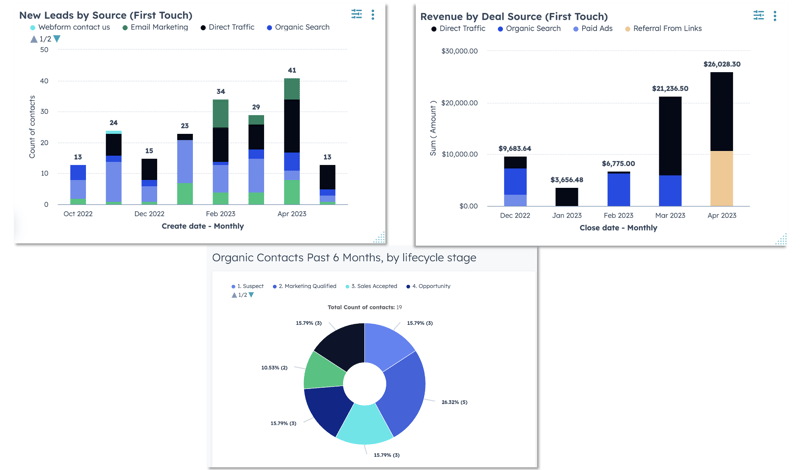75% of high-growth companies are expected to introduce some form of a Revenue Operations (RevOps) program by the end of 2025. But many will leave money on the table when they do so - because they will be using the wrong RevOps software.
This guide explains why HubSpot is the best platform to deliver the full promise of RevOps. It leverages decades of collective experience from our team’s RevOps experts, revealing a range of actionable insights that will ensure you don’t miss out on HubSpot’s best RevOps use cases.
Expect to learn:
- The three most important RevOps features in HubSpot
- The secret to creating optimal lifecycle stages
- The best way to increase revenue using HubSpot automation
RevOps Strategies for Accelerated Growth:
See How a SaaS Company Boosted Inbound Revenue by 466%
Why is HubSpot the Ideal Platform for RevOps?
RevOps is highly complex and can be very technically challenging. Your team is expected to optimize everything from sales and marketing alignment to bottom-of-the-funnel conversion rates - all within the same organizational function.
An effective RevOps strategy will include:
- Process Optimization: RevOps streamlines and improves processes across sales, marketing and customer success teams. This involves mapping the buyer’s journey, identifying bottlenecks and implementing time-saving workflows.
- Tech Stack Integration: A critical aspect of RevOps in HubSpot is integrating different tools and technologies that sales, marketing and customer success teams use. This integration enables seamless data flow and promotes team cohesion, allowing for a holistic view of the customer and enabling better decision-making.
- Data Analysis: A RevOps strategy emphasizes the importance of data-driven decision-making. RevOps focuses on centralizing data from various sources, such as customer relationship management (CRM) systems, marketing automation platforms, customer support tools and beyond – all so that organizations can conduct a full-picture analysis of data and gain valuable insights to optimize their revenue generation efforts.
- Performance Measurement and Reporting: RevOps involves establishing agreed-upon key performance indicators (KPIs) and metrics to measure the effectiveness of revenue-generating activities. By tracking and analyzing the same metrics across departments and teams, you can identify areas for improvement and optimize revenue operations.
- Team Collaboration and Communication: RevOps breaks down departmental silos and encourages cross-functional collaboration and communication. This ensures that teams work together towards common revenue goals, share insights and best practices, and collectively address customer needs in a way that shows leads consistency.
Clearly, this is a lot to manage - especially if you don’t have a dedicated RevOps team. It can easily spiral into an unmanageable workload, which means many organizations end up with abandoned or underutilized RevOps functions.
That is why HubSpot is so valuable: with access to multiple Hubs via a single platform, it helps to simplify the process and enables you to:
- Access all the data you need across multiple departments
- Build and leverage custom automations to optimize your funnels and reduce waste
- View the impact of your efforts with ease using specific RevOps dashboards
Which HubSpot Features Are Most Important for RevOps?
HubSpot has a wide range of powerful features, but three stand out from the perspective of RevOps:
1. HubSpot CRM
HubSpot's CRM is designed to help businesses effectively manage customer relationships and streamline sales processes. It offers many features and tools that enable companies to organize, track and nurture their leads and customers. The CRM features:
- A Contact Management System (CMS): Store and manage all your customer data in a centralized database, making it easy to access and update information. Users can view contact details, track interactions and record important notes and sales activities. This comprehensive view of customer information lets you personalize communication and provide a better customer experience.
- Sales Pipeline Management: Gain a visual representation of the sales process, which allows you to track deals from initial contact to closing. Users can create customizable stages, set reminders and assign tasks to team members – ensuring that nothing falls through the cracks. This streamlined approach helps businesses prioritize leads, identify bottlenecks and improve overall sales efficiency.
- Email Tracking and Templates: Send personalized emails, track open and click-through rates, and gain insights into customer engagement. It also integrates with other HubSpot tools, such as marketing automation and customer service, which gives you a holistic view of the buyer and customers' journeys.
How It Supports RevOps
HubSpot's CRM makes executing your RevOps strategy simple by providing a single source of truth across multiple departments. You can enhance customer relationships by providing a complete view of interactions and enabling personalized communication. Your sales teams can stay organized and focused, and a seamless data flow will exist between departments.
Ultimately, this helps you deliver a consistent and cohesive customer experience that enhances the bottom line – which is what RevOps is all about.
2. Marketing & Sales Automation
HubSpot's marketing automation capabilities empower businesses to automate and optimize their marketing efforts throughout the customer lifecycle with features including:
- Lifecycle Stage Management: Define and track leads’ stages, from the initial awareness stage to becoming a customer. By automating the movement of leads between stages based on predefined criteria, you can deliver the right messages to the right audience at each stage, nurturing leads toward conversion with minimal effort.
- Deal Stages: Represent the different steps in the sales process, from initial contact to closing a deal. You can automate deal stage updates based on predefined actions or criteria to easily track and manage the progress of each deal. This automation helps sales teams stay organized, prioritize deals, and take appropriate steps to move deals forward. It also provides valuable insights into the sales pipeline, allowing businesses to identify bottlenecks and optimize their sales processes for better results.
How It Supports RevOps
Marketing automation in HubSpot saves all departments time and effort by automating repetitive tasks, but it does much more than just that. With automation, you can deliver personalized and targeted messages to leads and customers, ensuring that leads receive relevant content and information at each funnel stage. So whether a lead is handled by marketing, sales, or, eventually, customer service, they receive cohesive messaging throughout - leading to improved conversions and scalable growth.
3. Full-Funnel Reporting
Your RevOps strategy is nothing without a way to track marketing and sales performance and return on investment (ROI). HubSpot's full-funnel reporting is a comprehensive analytics feature that provides a holistic view of the funnel, from initial lead acquisition to customer conversion and beyond. Some key features include:
- Detailed Campaign Tracking: Track and measure the performance of marketing campaigns at each stage of the funnel. This includes metrics such as website traffic, lead generation, conversion rates, and customer acquisition cost (CAC). By having visibility into the entire funnel, you can identify which marketing channels, campaigns, or tactics are most effective in driving results and scale them.
- Attribution Model: Attribute revenue and other key metrics to specific marketing activities or touchpoints along the customer journey. This helps businesses understand the impact of different marketing and sales efforts and make data-driven decisions to optimize their strategies. By accurately attributing revenue, companies can allocate their marketing budget more effectively and focus on activities that generate the highest return on investment.
How It Supports RevOps
HubSpot's full-funnel reporting provides valuable insights and facilitates collaboration between marketing and sales. Reporting increases visibility for all teams, establishes ROI clarity, empowers data-driven decision-making, and keeps everyone aligned on and aware of revenue and growth goals - no matter what department they’re in.
3 Tips to Improve Your RevOps Program Using HubSpot
While individual HubSpot features are important, how you use them will determine your RevOps program’s success. Based on our experience helping countless B2B companies leverage the platform to drive more revenue, here are three steps every company should take:
1. Plan For RevOps During Onboarding
Most companies consider the process of migrating their CRM a hurdle, but it can actually be a great opportunity to start improving your revenue processes. From eliminating duplicates in your customer data and automating tedious processes to establishing a service-level agreement (SLA) between sales and marketing, the HubSpot onboarding process offers an opportunity to click “reset” on various factors that have held your business back.
The best way to do this is to choose an onboarding partner with proven RevOps expertise. They will build your HubSpot setup around RevOps best practices – and help you start driving more revenue faster.
2. Create Custom Dashboards
Many B2B companies have access to the right data to optimize their revenue processes - it’s just too difficult to glean insights from the data. HubSpot enables you to create custom dashboards that bring together relevant information and allow you to quickly assess the effectiveness of your revenue processes.
A simple example is inbound marketing: we have developed a powerful framework to create dashboards that help leaders quickly and accurately evaluate the impact inbound campaigns have on their bottom line. This enables them to make data-driven decisions about future investment in specific channels and optimize existing campaigns.

3. Map Your Ideal Buyer’s Journey
The key to sales and marketing alignment is often a map of the buyer's journey. When the two departments cannot agree on lifecycle definitions or what constitutes a “qualified lead,” they will inevitably struggle to work together – and resentments can quickly grow.
Use HubSpot to create custom lifecycle stages that reflect your specific buyer journey and how your teams approach the lead nurture process. Each stage should be:
- Measurable: Ensure you can track the progress of deals with data from HubSpot
- Universal: Only use stages that will be applicable to all prospects and clients
- Meaningful: The movement between lifecycle stages should indicate clear progress in the buyer journey
Make HubSpot Your Ultimate Growth Engine with ProperExpression
HubSpot can transform your revenue processes - but only if you find the right partner to unlock its full potential.
ProperExpression helps B2B companies across numerous complex industries generate, nurture and convert more leads using HubSpot. Our team boasts expertise across RevOps, marketing, HubSpot strategy and HubSpot development - helping us deliver:
- Faster Onboarding: Our expert team combines a proven framework with strategies tailored to your specific business needs. As a result, we can complete onboarding within 60 days - and ensure every aspect of your setup is built upon RevOps best practices.
- Smoother Processes: From automating and enhancing lead handoffs to establishing regular lead reviews, we help your sales and marketing teams get the most from HubSpot and work together to deliver more high-value deals.
- Higher ROI: With everything from content marketing to paid media, we have helped clients increase their inbound generated revenue by 466%.
Want our team to assess your HubSpot setup and identify at least three ways you could drive more revenue?







